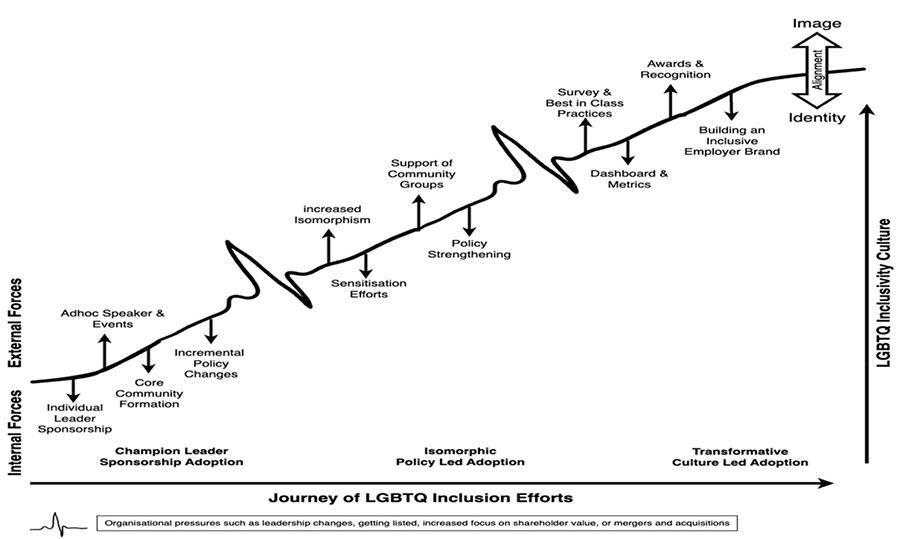Importance of enabling LGBTIQA+ inclusion by corporate India
The celebration of Pride Month may be seen by some sceptics as "pinkwashing", but it is often the start of a long and arduous journey toward building a truly inclusive organisation


We are celebrating Pride Month with sporadic initiatives by organisations to demonstrate their inclusive behaviours. The community forms a significant portion of our population. The 1948 study by Alfred Kinsey in the US, which suggested that 10 percent of males were gay, was challenged by researchers then. However, obtaining accurate data on gender and sexual identities remains a challenge. A study by Ipsos[1], a global market research agency, shows an increasing trend of Gen-Z members acknowledging their LGBTIQA+ affiliations, with over 18 percent stating them. In comparison, 14 percent are not willing to commit to their status. Today, there are an estimated 45.4 million members of the LGBTIQA+ population in India. Due to their inability to openly own their identity or due to discrimination or persecution, this estimated population is at a higher risk of developing a variety of physical and mental health conditions.
The concept of decent work is a global issue, emphasised in human rights declarations and United Nations resolutions like the 2030 Agenda for Sustainable Development under SDG-8. It aims to provide productive, fair income, workplace security, social protection, and better opportunities for personal development and social integration. However, this ethos is not reflected in employment for employees from sexual and gender minorities. Studies show that 42 percent of LGBTIQA+ employees experience discrimination based on their sexual orientation, and 90 percent of transgender respondents experience harassment or mistreatment. A recent investigation revealed that 34.2 percent of queer employees have resigned due to discriminatory treatment.
Homosexuality and acknowledging fluid gender identities are not historically new in India. Hinduism and Indian religious literature have a long history of featuring homosexual themes and people who have taken neutral or hostile stances. The androgynous sculpture, “Ardhanarishwar," or “the half-female Lord," is frequently seen in numerous holy temples and depicts Lord Shiva and His bride, Parvathi. Though androgynous representations as a third sex are not found in Hindu mythology, this early recognition of the fusion of masculine and feminine forces is acknowledged. While the Arthashastra treated homosexuality as a minor sin but did not openly sanction it, the Kamasutra contained a chapter on gay behaviour. Despite Sharia’s prohibitions on homosexuality throughout the Mughal era, numerous documented cases of homosexual behaviour suggest that it was a widespread practice.
Nonetheless, homosexuality was declared illegal during British colonialism as “acts against nature." The Supreme Court of India only overturned Section 377 of the Indian Penal Code in September 2018, after it had been in effect since 1861. The Supreme Court affirmed the 2009 Delhi High Court ruling in Naz Foundation v. Govt. Of NCT, Delhi, however, during the following ten years, the court reversed itself on several rulings. The early 1990s saw the beginning of the LGBTIQA+ movement and its fight for community rights, which resulted in numerous demonstrations and court cases over 25 years. Therefore, the societal acceptance of LGBTIQA+ is slow but changing.
India has made progress in promoting the acceptance and inclusion of the LGBTIQA+ community through the decriminalisation of homosexuality and the formulation of the Transgender Persons (Protection of Rights) Act. However, these legal changes are often limited and do not translate into immediate societal or attitudinal changes. Social spaces in India often fail to provide an inclusive environment forLGBTIQA+ individuals, including in workspaces. India’s cis-hetero normative culture is reflected in workplace policies and informal practices. In 2016, 40 percent of respondents reported workplace harassment based on their LGBTIQA+ identity. In 2023, 70 percent of LGBTIQA+ employees in India experienced non-inclusive behaviours, compared to a global average of 42 percent.
Organisations are talking about workplace acceptance more and more, which makes sense given the nation’s constantly shifting sexual demographic and how laws and other factors shape it. However, the business case for LGBTIQA+ inclusion is not evident for many organisations or appears to be an isomorphic fad. Studies on diversity and inclusion present three clear rationales for organisations to embrace LGBTIQA+ members into the workforce:
1. Enabling Access and Establishing Legitimacy: Given the large percentage of the population that openly or overtly are from the community, these constitute powerful consumer groups. By not being seen as inclusive, organisations could lose access to these significant consumer groups, which clearly does not make business sense.
2. All research on diversity and inclusion points to increased innovation through the diversity of thought from intersectionality within talent. Furthermore, the large representation of the community is a potential goldmine of hidden talent in a talent-scarce labour market, where the “war for talent" continues.
3. Social exclusion or isolation of LGBTIQA+ people is estimated to impact the national economy. It could cost the Indian economy $32 billion a year, or around 1.7 percent of its GDP, according to a 2014 World Bank study. Therefore, legislation promoting equitable work environments and policies is also warranted.
However, there are many challenges in building a truly LGBTIQA+ inclusive culture. Our study of organisations on this journey indicates that internal and external champions and leaders could start the journey ( See Figure 1).
 FIGURE 1: JOURNEY OF LGBTIQA+ INCLUSION EFFORTS IN ORGANISATIONS Source: Dutta, D. and Srinivasan, V. (2024), “Inclusion for LGBTIQA+ talent: a practice theory approach", Equality, Diversity and Inclusion, Vol. ahead-of-print No. ahead-of-print. https://doi.org/10.1108/EDI-09-2023-0296
FIGURE 1: JOURNEY OF LGBTIQA+ INCLUSION EFFORTS IN ORGANISATIONS Source: Dutta, D. and Srinivasan, V. (2024), “Inclusion for LGBTIQA+ talent: a practice theory approach", Equality, Diversity and Inclusion, Vol. ahead-of-print No. ahead-of-print. https://doi.org/10.1108/EDI-09-2023-0296
The efforts could get diluted or derailed if organisations experience flux, slowdown in growth, re-structuring, downsizing, or a merger/acquisition. Furthermore, a change in leadership or financial pressures may also see a shift in organisational priorities and focus.
However, as momentum builds and allyship with external community groups increases, organisations strengthen their policies and internal awareness-building and sensitisation initiatives. Organisations that mature in these processes become evangelists of the inclusion practices, often signalled as “best in class," and the fly-wheel momentum of inclusion transforms the entire organisation. Therefore, the celebration of Pride Month may be seen by some sceptics as “pinkwashing", but it is often the start of a long and arduous journey toward building a truly inclusive organisation. As a journey of a thousand miles starts with a first step, let us start that journey.
Debolina Dutta, Professor of Practice - Organizational Behaviour & HRM, IIM Bangalore
First Published: Jun 06, 2024, 12:22
Subscribe Now